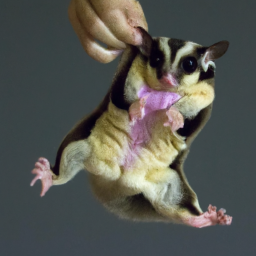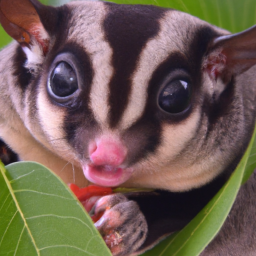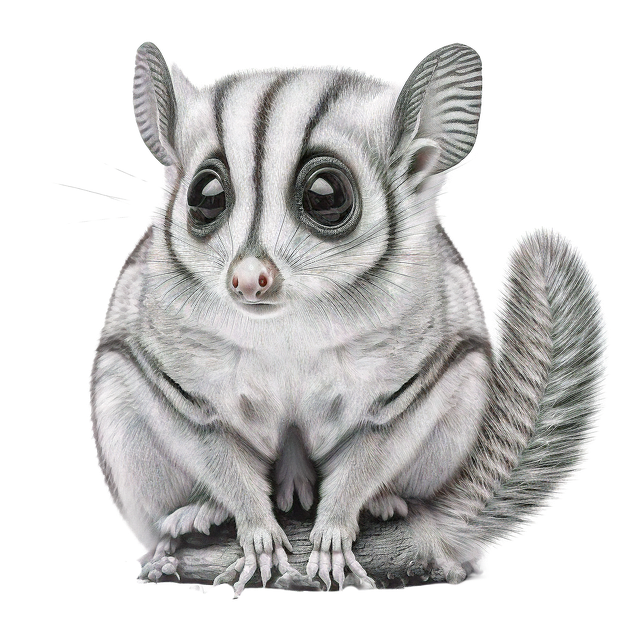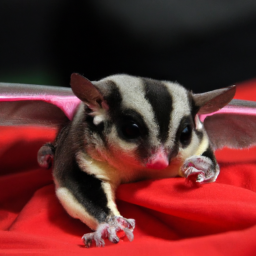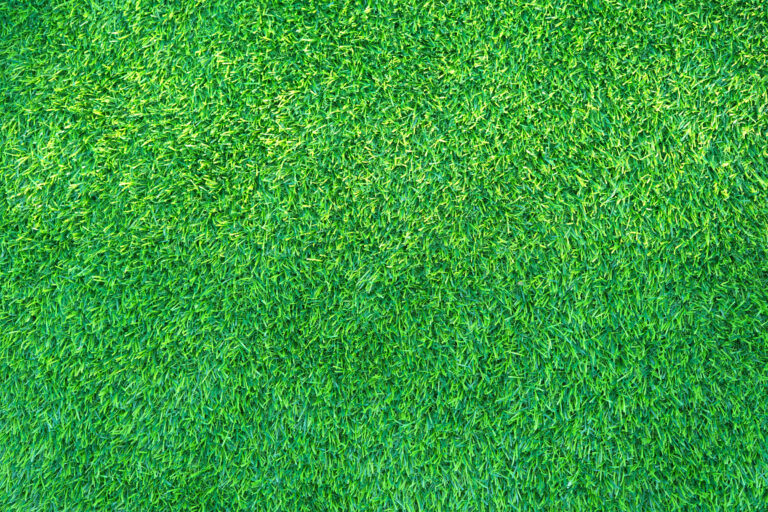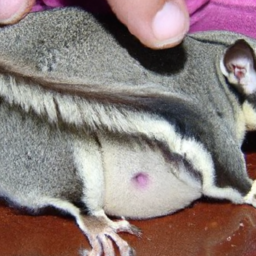Flying Squirrel Compared To Sugar Glider
Physical Features
Physical Features of Flying Squirrel
Flying squirrels are small arboreal rodents that are known for their ability to glide through the air. They have a unique physical structure that allows them to do so. One of the most notable physical features of flying squirrels is their patagium, a special membrane that stretches from their wrists to their ankles. This membrane acts as a parachute, allowing the flying squirrel to glide through the air. Their bodies are also compact, with a slender neck and long, bushy tail that helps with balance during flight. Flying squirrels are typically small in size, ranging from 8 to 12 inches in length, with a weight of around 3 to 6 ounces.
Physical Features of Sugar Glider
Sugar gliders, on the other hand, are small marsupials that also have the ability to glide. Unlike flying squirrels, sugar gliders have a patagium that extends from their forelimbs to their hindlimbs, making it more efficient for them to glide. They have a similar body structure to flying squirrels, with a slender build, a long and bushy tail for balance, and large, wide eyes that help with their nocturnal vision. Sugar gliders are slightly larger than flying squirrels, measuring around 10 to 12 inches in length, with a weight ranging from 3 to 6 ounces.
Habitat
Habitat of Flying Squirrel
Flying squirrels are native to various regions of the world, including North America, Europe, and Asia. They are often found in deciduous and coniferous forests, where they can easily climb trees and glide from branch to branch. These forests provide ample food sources for flying squirrels, such as nuts, seeds, fruits, and insects. They prefer to make their nests in tree cavities or build their own leaf nests for shelter.
Habitat of Sugar Glider
Sugar gliders are native to Australia, New Guinea, and Indonesia. They inhabit a range of environments, from tropical rainforests to woodland areas. Similar to flying squirrels, sugar gliders are excellent climbers and gliders. They rely on their strong limbs and sharp claws to navigate through the trees in search of food, which mainly consists of nectar, sap, fruits, and insects. Sugar gliders create nests in tree hollows or construct nests out of leaves and twigs.
Diet
Diet of Flying Squirrel
Flying squirrels are omnivorous creatures, meaning they consume a variety of food items. Their diet primarily consists of nuts, seeds, berries, fruits, and insects. They have sharp teeth and strong jaws that allow them to crack open nuts and seeds. Flying squirrels are known to be opportunistic feeders, taking advantage of available food sources depending on the season.
Diet of Sugar Glider
Sugar gliders are also omnivores, but they have a slightly different diet compared to flying squirrels. They have a strong preference for sweet foods, particularly nectar and sap from trees. They also consume a variety of fruits, insects, and even small vertebrates. Sugar gliders have a specialized tooth structure that enables them to extract nectar from flowers, making it an important part of their diet.
Nocturnal Behavior
Nocturnal Behavior of Flying Squirrel
Flying squirrels are primarily nocturnal animals, meaning they are most active during the night. This behavior helps them avoid predators and also allows them to take advantage of the night sky for gliding. During the day, they rest in their nests or tree cavities, conserving energy for their nightly activities. Flying squirrels have keen senses, including excellent night vision, which aids them in navigating through the dark forest.
Nocturnal Behavior of Sugar Glider
Sugar gliders, like flying squirrels, are also nocturnal animals. They are most active during the night, using their large, wide eyes to see in low light conditions. Their diet and behavior are adapted to the nocturnal lifestyle, as they forage for food, socialize with other sugar gliders, and glide from tree to tree in search of resources. Sugar gliders communicate through a series of vocalizations and scent marking, enhancing their social interactions at night.
Adaptations for Gliding
Adaptations for Gliding in Flying Squirrel
Flying squirrels have evolved various adaptations to excel in gliding. Their patagium, a stretchy membrane of skin, is the key adaptation that allows them to glide through the air. The patagium is supported by elongated wrist and ankle bones, providing stability during flight. The fur on their bodies also aids in gliding, as it helps to streamline their shape and reduce air resistance. The combination of these adaptations enables flying squirrels to maneuver gracefully through the forest canopy.
Adaptations for Gliding in Sugar Glider
Sugar gliders share similar adaptations for gliding with flying squirrels. They also have a patagium that stretches from their forelimbs to their hindlimbs, allowing them to glide long distances. Sugar gliders have a unique adaptation called “patagial bracing,” where they can control the shape and control of their patagium through muscle contractions. This flexibility allows them to change direction and adjust their glide trajectory. Sugar gliders are known for their acrobatic gliding skills, using their adaptations to navigate through the treetops efficiently.
Reproduction
Reproduction of Flying Squirrel
Flying squirrels have a reproductive cycle that varies depending on the species and habitat. Generally, they have a breeding season during the spring or early summer months. Female flying squirrels are typically in heat for a few days, during which they attract multiple males. After mating, the female builds a nest in a tree cavity or leaf nest and gives birth to a litter of two to five young. The young squirrels are born blind and hairless but develop quickly under the care of their mother.
Reproduction of Sugar Glider
Sugar gliders have a unique reproductive system, considering they are marsupials. Females have a reproductive cycle similar to other marsupials, with a short gestation period of around 15 to 17 days. After giving birth to underdeveloped joeys, which are about the size of a grain of rice, the joeys crawl into their mother’s pouch and attach themselves to a teat. They continue to grow and develop inside the pouch, eventually emerging after two to three months. Sugar gliders have a breeding season that occurs throughout the year, with multiple births possible.
Social Structure
Social Structure of Flying Squirrel
Flying squirrels exhibit a variety of social structures depending on the species. Some species are solitary, with each individual maintaining a territory that they defend against others. Other species are more social, forming small family groups or colonies. These groups consist of a dominant breeding pair and their offspring from previous breeding seasons. Within these groups, flying squirrels communicate through various vocalizations and scent marking to establish territorial boundaries and maintain social cohesion.
Social Structure of Sugar Glider
Sugar gliders are highly social animals that live in large groups called colonies. These colonies can consist of up to seven adult males and females, as well as their offspring. Within the colony, there is a dominant male and female pair that leads the group. The rest of the adult members help with raising the young and maintaining the social structure of the colony. Sugar gliders communicate through a complex system of vocalizations, visual displays, and scent marking to establish hierarchy and maintain social bonds.
Predators
Predators of Flying Squirrel
Flying squirrels face various predators in their habitats. Some common predators include owls, hawks, snakes, and larger mammals such as raccoons and foxes. These predators rely on their keen sense of hearing and vision to locate flying squirrels in the trees and capture them. The ability to glide allows flying squirrels to escape from some predators, as they can quickly glide to a nearby tree or into dense vegetation.
Predators of Sugar Glider
Sugar gliders also have a range of predators in their natural habitats. Owls and other birds of prey pose a significant threat to sugar gliders, as they are adept at capturing them during their nightly activities. Other predators include snakes, goannas, and feral cats. Sugar gliders rely on their gliding abilities to escape from predators, using their agility and speed to navigate through the trees and reach safety.
Conservation Status
Conservation Status of Flying Squirrel
The conservation status of flying squirrels depends on the species and the region they inhabit. Some species of flying squirrels are listed as “Least Concern” by the International Union for Conservation of Nature (IUCN), indicating that they are not currently at risk of extinction. However, habitat loss and degradation pose a threat to their populations, especially in areas where deforestation is prevalent. Conservation efforts focus on preserving and restoring suitable forest habitats for flying squirrels to thrive.
Conservation Status of Sugar Glider
The conservation status of sugar gliders also varies depending on the region and species. Some species are listed as “Least Concern” by the IUCN, while others are listed as “Near Threatened” or “Vulnerable.” Habitat loss, illegal pet trade, and predation by introduced predators are major threats to sugar glider populations. Conservation efforts aim to protect their natural habitat, regulate the pet trade, and raise awareness about the importance of preserving their populations.
Can Eye Infections Affect a Flying Squirrel Like They Do a Sugar Glider?
Yes, eye infections can affect a flying squirrel just as they do a sugar glider. It’s important to seek proper sugar glider eye infection treatment to prevent any complications. Keeping an eye on any changes in their behavior or appearance can help catch any issues early.
Conclusion
Flying squirrels and sugar gliders are fascinating creatures that share similarities in their physical features, habitat preferences, diet, and behavioral adaptations. Both species have evolved unique abilities to glide through the air, using specially adapted membranes and limbs for efficient flight. They are nocturnal animals that rely on their keen senses to navigate through their environments and find food. While they have different reproductive and social structures, both flying squirrels and sugar gliders face similar threats, such as habitat loss and predation. Efforts to conserve and protect these remarkable animals are crucial for their survival in the wild.
